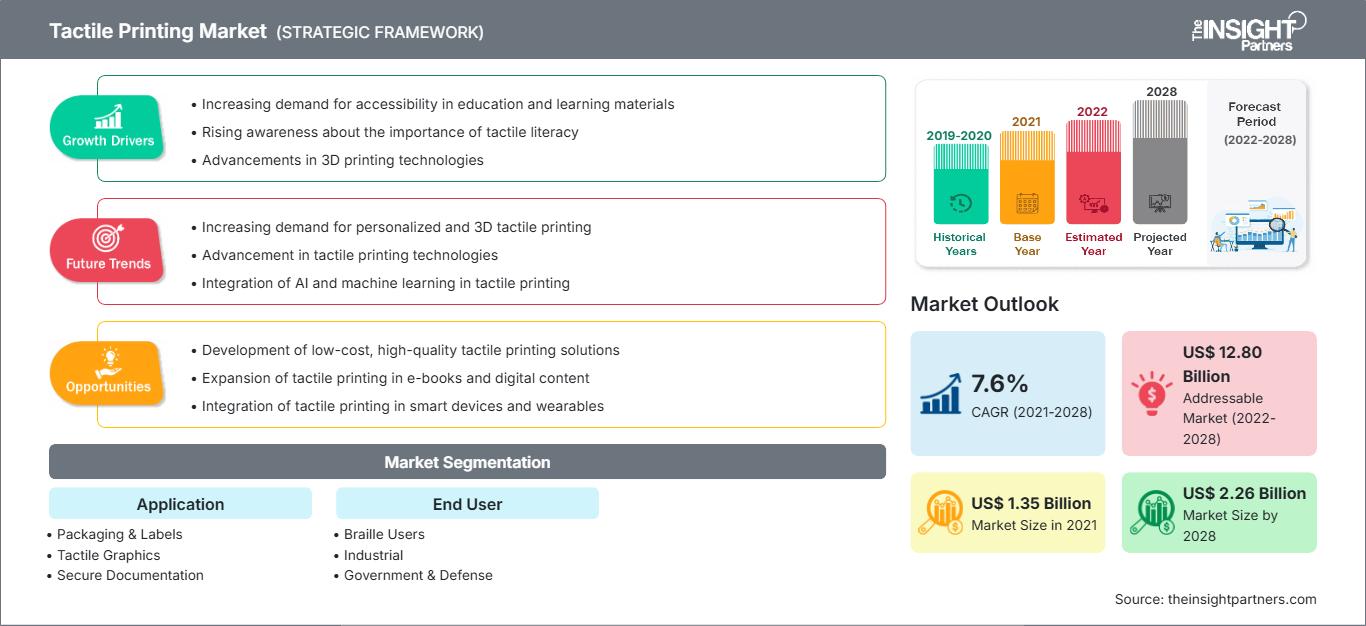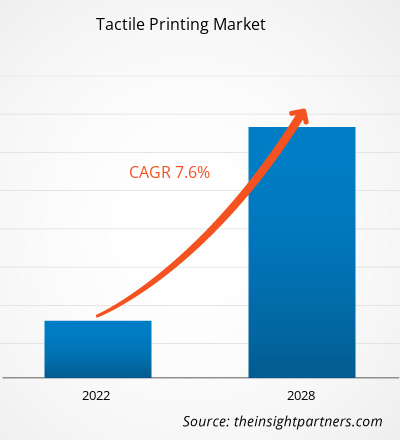El mercado de impresión táctil se valoró en US$ 1.353,27 millones en 2021 y se proyecta que alcance los US$ 2.257,92 millones para 2028; se espera que crezca a una CAGR del 7,6% de 2021 a 2028.
La impresión táctil es un proceso que crea una textura sobre un sustrato de impresión, la cual se puede percibir al tacto. La impresión táctil encuentra diversas aplicaciones en los sectores farmacéutico, de empaquetado médico, servicios humanos, ciencias de la salud, agricultura, servicios y otros. La demanda de impresión táctil se ve impulsada principalmente por el creciente uso de esta técnica en cartografía, etiquetado, empaquetado, seguridad y documentación segura. Además, el aumento de las inversiones en la tecnología de impresión braille, debido a la creciente demanda de soluciones personalizadas como juegos, pulseras, tarjetas musicales, pines, interruptores, tarjetas de visita, etiquetas de ubicación, pegatinas, tarjetas de felicitación y calculadoras impresas en braille, está impulsando el crecimiento del mercado de la impresión táctil. Con muchos países centrados en fomentar el empleo de personas con discapacidad visual, la industria de la impresión braille presenta importantes oportunidades para los actores del mercado de la impresión táctil.
Personalice este informe según sus necesidades
Obtendrá personalización en cualquier informe, sin cargo, incluidas partes de este informe o análisis a nivel de país, paquete de datos de Excel, así como también grandes ofertas y descuentos para empresas emergentes y universidades.
Mercado de impresión táctil: Perspectivas estratégicas

-
Obtenga las principales tendencias clave del mercado de este informe.Esta muestra GRATUITA incluirá análisis de datos, desde tendencias del mercado hasta estimaciones y pronósticos.
Impacto de la pandemia de COVID-19 en el mercado de la impresión táctil
Debido a las interrupciones en la oferta y la demanda a lo largo de la cadena de valor, las empresas que operan en el mercado global de la impresión táctil están experimentando una disminución de sus ingresos y crecimiento empresarial. Por lo tanto, el brote frenó en cierta medida el crecimiento general del mercado en 2020. Sin embargo, debido al aumento previsto de la demanda de los usuarios comerciales e industriales a nivel mundial, se espera que el crecimiento del mercado se normalice a partir del tercer trimestre de 2021 y continúe creciendo a un ritmo constante entre 2021 y 2028.
Perspectivas del mercado de la impresión táctil
Creciente demanda de gráficos táctiles para empoderar a las personas con discapacidad visual
Los empleadores de pequeñas y medianas empresas ofrecen oportunidades de empleo a una amplia gama de candidatos, incorporando a la fuerza laboral a personas con discapacidad física. En consecuencia, sectores como el marketing, la administración y gestión empresarial, los servicios humanos, las ciencias de la salud y la agricultura están empleando a gran escala a personas con discapacidad visual. Otros sectores que emplean a personas con discapacidad visual incluyen organizaciones sin fines de lucro; gobiernos locales, estatales y federales; y empresarios autónomos. Los cambios legislativos y las leyes de derechos civiles también impactan positivamente las oportunidades profesionales de las personas con discapacidad visual. Por lo tanto, los paneles de señalización táctil y los mapas tienen una gran demanda para ayudar a estas personas en sus lugares de trabajo.
Perspectivas del mercado basadas en aplicaciones
Según su aplicación, el mercado de la impresión táctil se segmenta en embalajes y etiquetas, gráficos táctiles y documentación segura. El segmento de embalajes y etiquetas lideró el mercado en 2020. La impresión táctil se aplica de forma destacada en las operaciones de embalaje y etiquetado en diversos sectores, lo que ayuda a las empresas a captar una base de clientes más amplia. Los materiales de embalaje y las etiquetas con impresión táctil también son útiles para las personas con discapacidad visual. Además, el uso de la impresión táctil facilita a las marcas una presentación moderna y elementos decorativos en sus embalajes, ofreciendo barreras y otras características especiales.
Los actores que operan en el
impresión táctil
El mercado adopta estrategias como fusiones, adquisiciones e iniciativas de mercado para mantener su posición. A continuación, se enumeran algunos avances de los actores clave:
- En 2020, ViewPlus Technologies Inc. presentó el punto Braille más resistente y legible de todas las impresoras Braille de escritorio, manteniendo una atractiva forma redondeada con el Power-Dot Braille, ya disponible. Las VP Delta 2 y VP Columbia 2 aún graban gráficos táctiles de alta resolución y Braille de la Biblioteca del Congreso (LOC).
- En 2021, Roland DGA Corporation anunció el lanzamiento de VersaUV LEC2-640 y LEC2-330, impresoras/cortadoras UV de última generación diseñadas exclusivamente para llevar la producción de etiquetas, envases, letreros, exhibidores y decoración de interiores a otro nivel.
Perspectivas regionales del mercado de la impresión táctil
Los analistas de The Insight Partners han explicado detalladamente las tendencias regionales y los factores que influyen en el mercado de la impresión táctil durante el período de pronóstico. Esta sección también analiza los segmentos y la geografía del mercado de la impresión táctil en Norteamérica, Europa, Asia Pacífico, Oriente Medio y África, y Sudamérica y Centroamérica.
Alcance del informe de mercado de impresión táctil
| Atributo del informe | Detalles |
|---|---|
| Tamaño del mercado en 2021 | 1.350 millones de dólares estadounidenses |
| Tamaño del mercado en 2028 | US$ 2.26 mil millones |
| CAGR global (2021-2028) | 7,6% |
| Datos históricos | 2019-2020 |
| Período de pronóstico | 2022-2028 |
| Segmentos cubiertos |
Por aplicación
|
| Regiones y países cubiertos |
América del norte
|
| Líderes del mercado y perfiles de empresas clave |
|
Densidad de actores del mercado de impresión táctil: comprensión de su impacto en la dinámica empresarial
El mercado de la impresión táctil está creciendo rápidamente, impulsado por la creciente demanda del usuario final debido a factores como la evolución de las preferencias del consumidor, los avances tecnológicos y un mayor conocimiento de los beneficios del producto. A medida que aumenta la demanda, las empresas amplían su oferta, innovan para satisfacer las necesidades del consumidor y aprovechan las tendencias emergentes, lo que impulsa aún más el crecimiento del mercado.

- Obtenga una descripción general de los principales actores clave del mercado de impresión táctil
El mercado de impresión táctil se ha segmentado de la siguiente manera:
Mercado de impresión táctil: por aplicación
- Embalaje y etiquetas
- Gráficos táctiles
- Documentación segura
Mercado de impresión táctil: por usuario final
- Usuarios de braille
- Industrial
- Gobierno y defensa
Mercado de impresión táctil por geografía
-
América del norte
- A NOSOTROS
- Canadá
- México
-
Europa
- Alemania
- Francia
- Italia
- Reino Unido
- Rusia
- Resto de Europa
-
Asia Pacífico (APAC)
- Australia
- Porcelana
- India
- Japón
- Corea del Sur
- Resto de APAC
-
Oriente Medio y África (MEA)
- Sudáfrica
- Arabia Saudita
- Emiratos Árabes Unidos
- Resto de MEA
-
América del Sur (SAM)
- Brasil
- Argentina
- Resto de SAM
Perfiles de empresas
- Altix
- Konica Minolta, Inc.
- Empresa de impresión de pistas de patinaje
- Impresión y diseño robustos Ltd.
- Termoformado americano
- Canon Inc
- Índice Braille
- Kanematsu Estados Unidos
- ViewPlus Technologies Inc
- Corporación Roland DG
- Análisis histórico (2 años), año base, pronóstico (7 años) con CAGR
- Análisis PEST y FODA
- Tamaño del mercado, valor/volumen: global, regional y nacional
- Industria y panorama competitivo
- Conjunto de datos de Excel
Informes recientes
Informes relacionados
Testimonios
Razón para comprar
- Toma de decisiones informada
- Comprensión de la dinámica del mercado
- Análisis competitivo
- Información sobre clientes
- Pronósticos del mercado
- Mitigación de riesgos
- Planificación estratégica
- Justificación de la inversión
- Identificación de mercados emergentes
- Mejora de las estrategias de marketing
- Impulso de la eficiencia operativa
- Alineación con las tendencias regulatorias






















 Obtenga una muestra gratuita para - Mercado de impresión táctil
Obtenga una muestra gratuita para - Mercado de impresión táctil